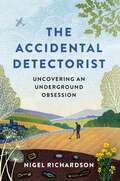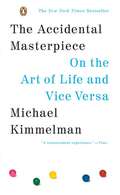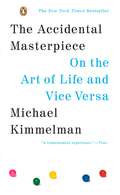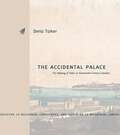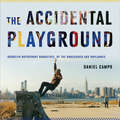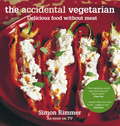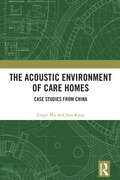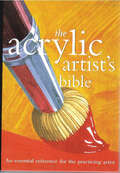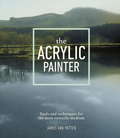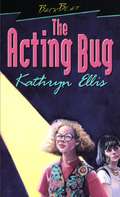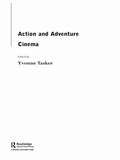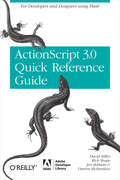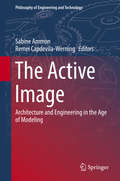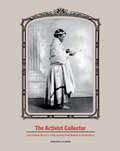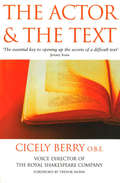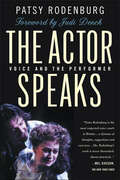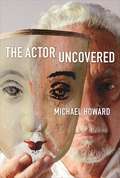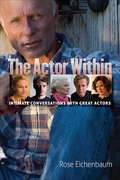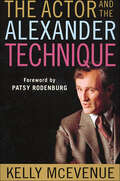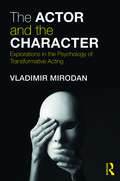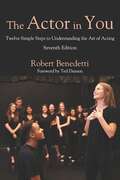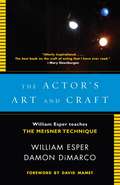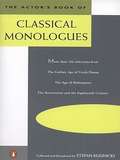- Table View
- List View
The Accidental Detectorist: Uncovering an Underground Obsession
by Nigel Richardson'Richardson writes beautifully about his return to the land, about listening to the soil and about understanding the ancient world.' - The SpectatorEach new field is hope, each old one reality.There are things below the surface that pull people together in a shared love of history, landscape and the hope that, this time, something incredible will be unearthed.When a travel writer is stuck on home soil in the middle of a pandemic he tries his hand at metal detecting - and is instantly addicted. This all-consuming hobby takes him around the country, back through history and deep into the psyches(his own included) of those hooked on 'happy bleeps'.The Accidental Detectorist is a big-hearted dig into a pastime sometimes mocked but always enticing.***When locked-down travel writer Nigel Richardson is looking for a travel story close to his country cottage he turns to a leading metal detectorist with an infectious passion for the hobby. Before he knows it the mysteries of the fields are leading him on, into a world that casts the history of these isles and its people in an intriguing new light.Sifting Britain's soil from Portsmouth to Edinburgh, Nigel yearns to lose his detectorist's virginity by finding a 'hammered' coin - while learning that the search for treasure comes with a serious responsibility to our common heritage. As he immerses himself further in the world of metal detecting, exposing the shady activities of 'nighthawks', attending rallies and making lifelong friends, a change comes over him. This country beneath his feet, these people who scour it for clues and tokens - they are the home he's been looking for.
The Accidental Masterpiece: On The Art Of Life And Vice Versa
by Michael KimmelmanA New York Times bestseller—a dazzling and inspirational survey of how art can be found and appreciated in everyday life. Michael Kimmelman, the prominent New York Times writer and a regular contributor to The New York Review of Books, is known as a deep and graceful writer across the disciplines of art and music and also as a pianist who understands something about the artist's sensibility from the inside. Readers have come to expect him not only to fill in their knowledge about art but also to inspire them to think about connections between art and the larger world - which is to say, to think more like an artist. Kimmelman's many years of contemplating and writing about art have brought him to this wise, wide-ranging, and long-awaited book. It explores art as life's great passion, revealing what we can learn of life through pictures and sculptures and the people who make them. It assures us that art - points of contact with the exceptional that are linked straight to the heart - can be found almost anywhere and everywhere if only our eyes are opened enough to recognize it. Kimmelman regards art, like all serious human endeavors, as a passage through which a larger view of life may come more clearly into focus. His book is a kind of adventure or journey. It carries the message that many of us may not yet have learned how to recognize the art in our own lives. To do so is something of an art itself. A few of the characters Kimmelman describes, like Bonnard and Chardin, are great artists. But others are explorers and obscure obsessives, paint-by-numbers enthusiasts, amateur shutterbugs, and collectors of strange odds and ends. Yet others, like Charlotte Solomon, a girl whom no one considered much of an artist but who secretly created a masterpiece about the world before her death in Auschwitz, have reserved spots for themselves in history, or not, with a single work that encapsulates a whole life. Kimmelman reminds us of the Wunderkammer, the cabinet of wonders - the rage in seventeenth-century Europe and a metaphor for the art of life. Each drawer of the cabinet promises something curious and exotic, instructive and beautiful, the cabinet being a kind of ideal, self-contained universe that makes order out of the chaos of the world. The Accidental Masterpiece is a kind of literary Wunderkammer, filled with lively surprises and philosophical musings. It will inspire readers to imagine their own personal cabinet of wonders.
The Accidental Masterpiece: On the Art of Life and Vice Versa
by Michael KimmelmanA New York Times bestseller—a dazzling and inspirational survey of how art can be found and appreciated in everyday lifeMichael Kimmelman, the prominent New York Times writer and a regular contributor to The New York Review of Books, is known as a deep and graceful writer across the disciplines of art and music and also as a pianist who understands something about the artist's sensibility from the inside. Readers have come to expect him not only to fill in their knowledge about art but also to inspire them to think about connections between art and the larger world - which is to say, to think more like an artist. Kimmelman's many years of contemplating and writing about art have brought him to this wise, wide-ranging, and long-awaited book.It explores art as life's great passion, revealing what we can learn of life through pictures and sculptures and the people who make them. It assures us that art - points of contact with the exceptional that are linked straight to the heart - can be found almost anywhere and everywhere if only our eyes are opened enough to recognize it. Kimmelman regards art, like all serious human endeavors, as a passage through which a larger view of life may come more clearly into focus. His book is a kind of adventure or journey.It carries the message that many of us may not yet have learned how to recognize the art in our own lives. To do so is something of an art itself. A few of the characters Kimmelman describes, like Bonnard and Chardin, are great artists. But others are explorers and obscure obsessives, paint-by-numbers enthusiasts, amateur shutterbugs, and collectors of strange odds and ends. Yet others, like Charlotte Solomon, a girl whom no one considered much of an artist but who secretly created a masterpiece about the world before her death in Auschwitz, have reserved spots for themselves in history, or not, with a single work that encapsulates a whole life.Kimmelman reminds us of the Wunderkammer, the cabinet of wonders - the rage in seventeenth-century Europe and a metaphor for the art of life. Each drawer of the cabinet promises something curious and exotic, instructive and beautiful, the cabinet being a kind of ideal, self-contained universe that makes order out of the chaos of the world. The Accidental Masterpiece is a kind of literary Wunderkammer, filled with lively surprises and philosophical musings. It will inspire readers to imagine their own personal cabinet of wonders.
The Accidental Palace: The Making of Yıldız in Nineteenth-Century Istanbul (Buildings, Landscapes, and Societies)
by Deniz TürkerThis book tells the story of Yıldız Palace in Istanbul, the last and largest imperial residential complex of the Ottoman Empire. Today, the palace is physically fragmented and has been all but erased from Istanbul’s urban memory. At its peak, however, Yıldız was a global city in miniature and the center of the empire’s vast bureaucratic apparatus.Following a chronological arc from 1795 to 1909, The Accidental Palace shows how the site developed from a rural estate of the queen mothers into the heart of Ottoman government. Nominally, the palace may have belonged to the rarefied realm of the Ottoman elite, but as Deniz Türker reveals, the development of the site was profoundly connected to Istanbul’s urban history and to changing conceptions of empire, absolutism, diplomacy, reform, and the public. Türker explores these connections, framing Yıldız Palace and its grounds not only as a hermetic expression of imperial identity but also as a product of an increasingly globalized consumer culture, defined by access to a vast number of goods and services across geographical boundaries.Drawn from archival research conducted in Yıldız’s imperial library, The Accidental Palace provides important insights into a decisive moment in the palace’s architectural and landscape history and demonstrates how Yıldız was inextricably tied to ideas of sovereignty, visibility, taste, and self-fashioning. It will appeal to specialists in the art, architecture, politics, and culture of nineteenth-century Turkey and the Ottoman Empire.
The Accidental Playground: Brooklyn Waterfront Narratives of the Undesigned and Unplanned
by Daniel CampoThe Accidental Playground explores the remarkable landscape created by individuals and small groups who occupied and rebuilt an abandoned Brooklyn waterfront. While local residents, activists, garbage haulers, real estate developers, speculators, and two city administrations fought over the fate of the former Brooklyn Eastern District Terminal (BEDT), others simply took to this decaying edge, transforming it into a unique venue for leisure, creative, and everyday practices. These occupiers and do-it-yourself builders created their own waterfront parks and civic spaces absent every resource needed for successful urban development, including plans, designs, capital, professional assistance, consensus, and permission from the waterfront’s owners. Amid trash, ruins, weeds, homeless encampments, and the operation of an active garbage transfer station, they inadvertently created the “Brooklyn Riviera” and made this waterfront a destination that offered much more than its panoramic vistas of the Manhattan skyline. The terminal evolved into the home turf for unusual and sometimes spectacular recreational, social, and creative subcultures, including the skateboarders who built a short-lived but nationally renowned skatepark, a twenty-five-piece “public” marching band, fire performance troupes, artists, photographers, and filmmakers. At the same time it served the basic recreational needs of local residents. Collapsing piers became great places to catch fish, sunbathe, or take in the views; the foundation of a demolished warehouse became an ideal place to picnic, practice music, or do an art project; rubble-strewn earth became a compelling setting for film and fashion shoots; a broken bulkhead became a beach; and thick patches of weeds dotted by ailanthus trees became a jungle. These reclamations, all but ignored by city and state governments and property interests that were set to transform this waterfront, momentarily added to the distinctive cultural landscape of the city’s most bohemian and rapidly changing neighborhood.Drawing on a rich mix of documentary strategies, including observation, ethnography, photography, and first-person narrative, Daniel Campo probes this accidental playground, allowing those who created it to share and examine their own narratives, perspectives, and conflicts. The multiple constituencies of this waterfront were surprisingly diverse, their stories colorful and provocative. When taken together, Campo argues, they suggest a radical reimagining of urban parks and public spaces, and the practices by which they are created and maintained. The Accidental Playground, which treats readers to an utterly compelling story, is an exciting and distinctive contribution to the growing literature on unplanned spaces and practices in cities today.
The Accidental Vegetarian: Delicious And Eclectic Food Without Meat
by Simon RimmerWhen Simon Rimmer bought a small vegetarian restaurant, he had no idea how to cook. Armed with two cookbooks and heaps of enthusiasm, he and a friend created the best vegetarian restaurant in Manchester, famous for its unusual food and lovely atmosphere. A confirmed meat eater, Simon had to rethink his cooking and has created vegetarian recipes to please even the most dedicated carnivore. This book is a collection of some of his recipes that are quick to prepare but totally delicious. From good old favourites like macaroni cheese to Simon's more exotic fusion creations such as spicy beetroot and coconut soup, The Accidental Vegetarian will kill the lentil and sandal image of vegetarianism forever!
The Accidental Vegetarian: Delicious food without meat
by Simon RimmerDeliciously simple, meat-free recipes from 'Something For The Weekend' presenter and Strictly Come Dancing contestant Simon Rimmer.
The Acoustic Environment of Care Homes: Case Studies from China
by Jian Kang Jingyi MuThis book examines the indoor acoustic environment of China's care homes. Chapter 1 provides a brief introduction to the current situation in China's care homes. This includes the distribution, size, demand, and future development direction of these facilities. The chapter then presents an in-depth introduction and analysis of the indoor environment of these facilities, especially the acoustic environment. In Chapter 2, a case study and site investigation are described, and these are used to analyse the current state of the acoustic environment in these facilities, including the sound pressure level (SPL) and reverberation time (RT). Chapter 3 details the perceptions of the elderly regarding the acoustic environment of care homes and the correlation between the sound environment and other physical environments at the facilities. Chapter 4 presents the impact of the acoustic environment on the well-being of elderly residents and an analysis of the effects of different sound sources on the activities of the elderly. The effects of the acoustic environment on physiological indices of the elderly under different sound sources in care homes are analysed in Chapter 5. Finally, in Chapter 6, certain improvement strategies for the indoor acoustic environment of care homes are proposed based on the analysis. This book is a comprehensive exposition of research on the acoustic environment of care homes in China, and is useful reading for researchers in acoustics, architecture, design, engineering, and healthcare facilities. It could also be used as a scientific introduction for readers interested in this field.
The Acrylic Artist's Bible: An Essential Reference for the Practicing Artist (Artist's Bibles Ser.)
by Marylin ScottThis guide to painting techniques and subjects includes photos, diagrams and illustrations, providing instruction for both beginner and advanced artists.With its great flexibility, acrylic paint can mimic the appearance of oils, tempera, and watercolors in unique ways, each method pictured in a separate step-by-step demonstration. The author also examines the use of acrylics with airbrush, sculptural, and printing techniques—even three-dimensional relief painting and collagraph printing methods are included—and how several of these different creative processes can be integrated successfully in one composition with ink, pencil, charcoal, and pastel. Inspiring examples of representational and abstract subjects are depicted throughout, and a complete survey of all the latest acrylic materials covers the best paint brands, painting mediums, supports, varnishes, brushes, knives, and palettes.This book contains instructions on painting many different subjects, like landscapes, trees, mountains, buildings, still lifes, and portraits. It makes an ideal gift for someone practiced in the arts of acrylic painting, and newcomers to the art form.
The Acrylic Painter: Tools and Techniques for the Most Versatile Medium
by James Van PattenA complete course on acrylic painting for beginners and experienced artists that covers classic approaches and new innovations Embraced for versatility, quick-drying properties, and non-toxicity, no medium offers a wider range of effects forcreating highly expressive art than acrylics. With its flexibility and ease of use, acrylic paint is a must-try for painters--no matter your skill level. Here noted artist and School of Visual Arts instructor James Van Patten draws from years of experience to show you how to use acrylics to achieve a variety of results--from watercolor-like transparency and the flatness of tempera and gouache to the buttery quality of oils. He presents an insider's look at the most up-to-date tools, materials, and techniques used by top painters in the medium to produce highly expressive art. Van Patten offers guidance on materials, processes, balance, and composition, and focuses on effectively using color in painting. Replete with detailed step-by-step technical demonstrations and a catalog of inspiring works by notable past and contemporary artists, as well as the author himself and his students, The Acrylic Painter provides a complete, classic art instruction manual for painters of all abilities in one of today's most popular types of paint.From the Trade Paperback edition.
The Acting Bug
by Kathryn EllisTV stardom – fame, fortune, and Hollywood! It’s the chance of a lifetime for Kate Merriman when she lands a small role in a new TV series called Backbeat. But it’s less fun when Kate finds out her best friend Maria has turned down the part she’s been offered in the show. They’re always there for each other. How can Kate succeed when Maria’s not there to share this new adventure. And why doesn’t their friendship seem to work any more? In her first novel in the Backbeat series, Kathryn Ellis provides a lively look into the world of TV shows – and close friendships.
The Action and Adventure Cinema
by Yvonne TaskerThis exciting collection addresses action and adventure from the silent to the contemporary period exploring diverse questions of aesthetics, industry and ideology. Action has established itself as one of the leading commercial genres of the New Hollywood cinema, generating extensive debate in the process.Contributors consider how action might best be defined, how it has developed historically, and how it works formally. The critical reception and standing of action and adventure cinema is considered in relation to questions of national culture, violence and the 'art' of cinema.Themes explored include genre and definitions; early action, sensation and melodrama; authorship and action; national and transnational action-adventure traditions; action aesthetics; spectacle and narrative; stars and bodies; class; gender; race and ethnicity. Attempting to evaluate the significance of this type of filmmaking for both popular cinema and film studies, the book underlines the central place of action and adventure within film history.
The ActionScript 3.0 Quick Reference Guide
by Rich Shupe Darren Richardson Jen Dehaan David StillerThis reference guide for ActionScript 3. 0 is aimed at Flash designers and developers who are currently using the 2. 0 version and need to adjust to the revisions and improvements as quickly as possible. Stiller, Shupe and Richardson are noted computer authors, and they are joined by deHaan, a software quality engineer for Adobe. Together they provide object-oriented programming tips that illustrate the player enhancements, workflow differences and new features while outlining the changes to the old 2. 0 features. A free online edition of this guide is available for 45 days after the purchase of this book. Annotation ©2009 Book News, Inc. , Portland, OR (booknews. com)
The ActionScript 3.0 Quick Reference Guide: For Developers and Designers Using Flash CS4 Professional (Adobe Developer Library)
by Rich Shupe Darren Richardson Jen Dehaan David Stiller"No matter what your background, the pages that follow will provide you with some excellent knowledge, insight, and even a little bit of wisdom in the realm of Flash and ActionScript. Happy learning!" -- Branden Hall, from the Foreword Written by Flash insiders with extensive knowledge of the technology, this guide is designed specifically to help Flash designers and developers make the leap from ActionScript 2.0 to the new object-oriented ActionScript 3.0 quickly and painlessly. Formatted so you can find any topic easily, ActionScript 3.0 Quick Reference Guide explains: Object-oriented programming (OOP) concepts, such as packages and classes ActionScript 3.0 features and player enhancements that improve performance Workflow differences between ActionScript 2.0 and ActionScript 3.0 including tools, code editing, component sets, and image and font rendering Where did it go? A guide to help you find familiar features in ActionScript 3.0, such as global functions, operators, properties, and statements How do I? Step-by-step solutions for performing tasks with ActionScript 3.0, including input, sound, video, display, events, text, and more Also included are overviews of Flash and ActionScript features and workflows. ActionScript 3.0 is a huge upgrade to Flash's programming language -- and this guide helps you upgrade your skills to match it.
The Active Image
by Sabine Ammon Remei Capdevila-WerningThe "active image" refers to the operative nature of images, thus capturing the vast array of "actions" that images perform. This volume features essays that present a new approach to image theory. It explores the many ways images become active in architecture and engineering design processes and how, in the age of computer-based modeling, images play an indispensable role. The contributors examine different types of images, be they pictures, sketches, renderings, maps, plans, and photographs; be they analog or digital, planar or three-dimensional, ephemeral, realistic or imaginary. Their essays investigate how images serve as means of representing, as tools for thinking and reasoning, as ways of imagining the inexistent, as means of communicating and conveying information and how images may also perform functions and have an agency in their own. The essays discuss the role of images from the perspective of philosophy, theory and history of architecture, history of science, media theory, cognitive sciences, design studies, and visual studies, offering a multidisciplinary approach to imagery and showing the various methodologies and interpretations in current research. In addition, they offer valuable insight to better understand how images operate and function in the arts and sciences in general.
The Activist Collector: Lida Clanton Broner’s 1938 Journey from Newark to South Africa
by Christa Clarke“After twenty-eight years of desire and determination, I have visited Africa, the land of my forefathers.” So wrote Lida Clanton Broner (1895–1982), an African American housekeeper and hairstylist from Newark, New Jersey, upon her return from an extraordinary nine-month journey to South Africa in 1938. This epic trip was motivated not only by Broner’s sense of ancestral heritage, but also a grassroots resolve to connect the socio-political concerns of African Americans with those of black South Africans under the segregationist policies of the time. During her travels, this woman of modest means circulated among South Africa’s Black intellectual elite, including many leaders of South Africa’s freedom struggle. Her lectures at Black schools on “race consciousness and race pride” had a decidedly political bent, even as she was presented as an “American beauty specialist.” How did Broner—a working class mother—come to be a globally connected activist? What were her experiences as an African American woman in segregated South Africa and how did she further her work after her return? Broner’s remarkable story is the subject of this book, which draws upon a deep visual and documentary record now held in the collection of the Newark Museum of Art. This extraordinary archive includes more than one hundred and fifty objects, ranging from beadwork and pottery to mission school crafts, acquired by Broner in South Africa, along with her diary, correspondence, scrapbooks, and hundreds of photographs with handwritten notations. Published by the Newark Museum. Distributed worldwide by Rutgers University Press.
The Actor And The Text
by Cicely BerryCicely Berry, Voice Director of the Royal Shakespeare Company, is world-famous for her voice teaching. The Actor and the Text is her classic book, distilled from years of working with actors of the highest calibre.
The Actor Speaks: Voice and the Performer
by Patsy RodenburgIn The Actor Speaks, Patsy Rodenburg takes actors and actresses, both professional and beginners, through a complete voice workshop. She touches on every aspect of performance work that involves the voice and sorts through the kinds of vexing problems every performer faces onstage: breath and relaxation; vocal range and power; communication with other actors; singing and acting simultaneously; working on different sized stages and in both large and small auditoriums; approaching the vocal demands of different kinds of scripts. This is the final word on the actor's voice and it's destined to become the classic work on the subject for some time to come.
The Actor Uncovered
by Michael HowardA Far-Reaching and Truthful Exploration of Acting in All Its FormsThe Actor Uncovered is certainly not a set of rigid rules advocating one "method" or one singular "truth." Departing from the common guidebook format, Michael Howard uses a unique approach to teaching acting, reflecting on his own history and sharing his own experiences as an actor, director, and teacher. How he writes about the process and craft of acting is at once intensely personal and relatable by others.Readers are invited to participate as though present in this master teacher's classes. Each human being, and thus each actor, is unique. Howard encourages actors to uncover their own ways of working, using their particular abilities and personality traits. Going beyond the craft and into human psychology and the importance of acting as a life force, readers will see new and deeper ways to study and practice, to be introspective, and to arrive at places of revelation about their craft.The Actor Uncovered will have much to say to beginners, to those who are advanced, and to professional and working actors. Howard discusses such topics as:Techniques, styles, and methods in a changing societyRelaxation, concentration, and the breathThe relationships among actor, director, and writerMemoryOn camera versus on stageObstaclesAfter more than seventy years as a professional actor, director, and teacher, Howard shows how living creatively and invoking one's own personality can lead to a successful career as an actor.
The Actor Within: Intimate Conversations with Great Actors
by Rose EichenbaumIn Rose Eichenbaum's third work on the confluence of art making and human expression, she delves into the lives of thirty-five celebrated actors through intimate conversations and photographic portraits. With her probing questions and disarming manner, she captures the essential character of her subjects while shining a light on the art that defines them. The work provides extraordinary insights on the craft of acting with discussions of process, techniques, tools of the trade, and how to advice for aspiring actors from seasoned veterans. These stars of stage and screen, known for signature roles and critically acclaimed performances, emerge in The Actor Within with masks and wardrobe removed. Here, they speak their own lines, tell their own stories, and raise the curtain on what it means to live the actor's life—the challenge of mastering their craft, the drama of big breaks and career woes, the search for meaningful roles, and above all, having the courage to bare their souls before theater audiences or the camera. For the artists featured in this work, acting is more than a profession; it is how they make their way in the world and artfully merge their inner sense of humanness with universal truths. This collection serves as an important inspirational resource for anyone interested in making art, regardless of medium.The Actor Within includes interviews with Karl Malden, Ruby Dee, Ed Harris, Piper Laurie, Marcia Gay Harden, William H. Macy, Ellen Burstyn, Joe Mantegna, Debra Winger, Julia Stiles, Elliott Gould, Elijah Wood, Stockard Channing, Bill Pullman, Amanda Plummer, Marlee Matlin, Charles Durning, Marsha Mason, and many others.
The Actor and the Alexander Technique
by Kelly McEvenueF.M. Alexander developed the Alexander Technique of movement in the early 20th century. Combining vocal clarity and body movement, Alexander developed a performance coaching method that is used by dancers, actors, singers, etc. In The Actor and the Alexander Technique, Kelly McEvenue writes the first basic book about how this unique technique can help actors feel more natural on the stage. She provides warm-up exercises, "balance" and "center" exercises, spatial awareness exercises. She talks about imitation, the use of masks, nudity on the stage, dealing with injury and aging. She talks about specific productions that have successfully used the Alexander Technique, such as "The Lion King". With a foreword by Patsy Rodenburg of our own phenomenal The Actor Speaks this is a book that belongs on the shelf of every working and studying actor.
The Actor and the Character: Explorations in the Psychology of Transformative Acting
by Vladimir MirodanTransformative acting remains the aspiration of many an emerging actor, and constitutes the achievement of some of the most acclaimed performances of our age: Daniel Day-Lewis as Lincoln, Meryl Streep as Mrs Thatcher, Anthony Hopkins as Hannibal Lecter – the list is extensive, and we all have our favourites. But what are the physical and psychological processes which enable actors to create characters so different from themselves? To understand this unique phenomenon, Vladimir Mirodan provides both a historical overview of the evolution of notions of 'character' in Western theatre and a stunning contemporary analysis of the theoretical implications of transformative acting. The Actor and the Character: Surveys the main debates surrounding the concept of dramatic character and – contrary to recent trends – explains why transformative actors conceive their characters as ‘independent’ of their own personalities. Describes some important techniques used by actors to construct their characters by physical means: work on objects, neutral and character masks, Laban movement analysis, Viewpoints, etc. Examines the psychology behind transformative acting from the perspectives of both psychoanalysis and scientific psychology and, based on recent developments in psychology, asks whether transformation is not just acting folklore but may actually entail temporary changes to the brain structures of the actors. The Actor and the Character speaks not only to academics and students studying actor training and acting theory, but contributes to current lively academic debates around character. This is a compelling and original exploration of the limits of acting theory and practice, psychology, and creative work, in which Mirodan boldly re-examines some of the fundamental assumptions of actor training and some basic tenets of theatre practice to ask: What happens when one of us ‘becomes somebody else’?
The Actor in You: Twelve Simple Steps to Understanding the Art of Acting
by Robert BenedettiSince the first edition of The Actor in You was published a quarter-century ago, thousands of students have benefited from Robert Benedetti's decades of experience educating some of the United States' finest actors. In this Seventh Edition, Benedetti expresses the fundamental elements of acting in simple language, leading readers through understanding their own bodies and voices, acting technique, and the basics of rehearsals and staging shows. Each step includes exercises to aid students in self-discovery and self-development as they grow from novices into practiced actors. Titles by Robert Benedetti also available from Waveland Press: Action!: Professional Acting for Film and Television, Second Edition (ISBN 9781478649397) and The Actor at Work, Eleventh Edition (ISBN 9781478649045).
The Actor's Art and Craft: William Esper Teaches the Meisner Technique
by William Esper Damon DimarcoWilliam Esper, one of the leading acting teachers of our time, explains and extends Sanford Meisner's legendary technique, offering a clear, concrete, step-by-step approach to becoming a truly creative actor.Esper worked closely with Meisner for seventeen years and has spent decades developing his famous program for actor's training. The result is a rigorous system of exercises that builds a solid foundation of acting skills from the ground up, and that is flexible enough to be applied to any challenge an actor faces, from soap operas to Shakespeare. Co-writer Damon DiMarco, a former student of Esper's, spent over a year observing his mentor teaching first-year acting students. In this book he recreates that experience for us, allowing us to see how the progression of exercises works in practice. The Actor's Art and Craft vividly demonstrates that good training does not constrain actors' instincts—it frees them to create characters with truthful and compelling inner lives.
The Actor's Book of Classical Monologues
by VariousA challenging, wide-ranging collection of monologues from history’s greatest dramatic works. From the stately and poetic Greek tragedies to the lively, bawdy Restoration comedies, the classical repertoire is a treasure trove of often-overlooked materials for male and female, young and old. The solo pieces collected here vary widely in mood, style, and level of challenge; they include a generous supply of Shakespeare and his contemporaries; and they’re fleshed out with brief plot synopses and valuable historical material. Stefan Rudnicki, an accomplished actor, director, and teacher, also provides practical tips on preparing each scene for audition or performance. Among the playwrights whose works are included are: Aeschylus Sophocles Euridipes Aristophanes Shakespeare Tourneur Kyd Middleton Jonson Sheridan Dryden Congreve …and many others.
